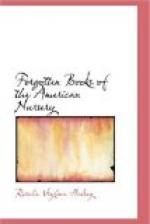In the year following the first appearance of Mrs. Hale’s “Juvenile Miscellany,” the March number is typical of the amusement and instruction the editor endeavored to provide. This contained a life of Benjamin Franklin (perhaps the earliest child’s life of the philosopher and statesman), a tale of an Indian massacre of an entire settlement in Maine, an essay on memory, a religious episode, and extracts from a traveller’s journal. The traveller, quite evidently a Bostonian, criticised New York in a way not unfamiliar in later days, as a city where “the love of literature was less strong than in some other parts of the United States;” and then in trying to soften the statement, she fell into a comparison with Philadelphia, also made many times since the gentle critic observed the difference. “New York,” she wrote, “has energy, spirit, and bold, lofty enterprise, totally wanting in Philadelphia, ... a place of neat, well regulated plans.” Also, like the English story-book of the previous century, this American “Miscellany” introduced Maxims for a Student, found, it cheerfully explained, “among the manuscripts of a deceased friend.” Puzzles and conundrums made an entertaining feature, and as the literary chef d’oeuvre was inserted a poem supposed to be composed by a babe in South Carolina, but of which the author was undoubtedly Mrs. Gilman, whose ideas of a baby’s ability were certainly not drawn from her own nursery.
A rival to the “Juvenile Miscellany” was the “Youth’s Companion,” established at this time in Boston by Nathaniel P. Willis and the Reverend Asa Rand. The various religious societies also began to issue children’s magazines for Sunday perusal: the Massachusetts Sunday School Union beginning in 1828 the “Sabbath School Times,” and other societies soon following its example.
“Parley’s Magazine,” planned by Samuel G. Goodrich and published by Lilly, Wait and Company of Boston, ran a successful course of nine years from eighteen hundred and thirty-three. The prospectus declared the intention of its conductors “to give descriptions of manners, customs, and countries, Travels, Voyages, and Adventures in Various parts of the world, interesting historical notes, Biography, particularly of young persons, original tales, cheerful and pleasing Rhymes, and to issue the magazine every fortnight.” The popularity of the name of Peter Parley insured a goodly number of subscriptions from the beginning, and the life of “Parley’s Magazine” was somewhat longer than any of its predecessors.
In the south the idea of issuing a juvenile magazine was taken up by a firm in Charleston, and the “Rose Bud” was started in eighteen hundred and thirty. The “Rose Bud,” a weekly, was largely the result of the success of the “Juvenile Miscellany,” as the editor of the southern paper, Mrs. Gilman, was a valued contributor to the “Miscellany,” and had been encouraged in her plan of a paper for children of the south by the Boston conductors of the northern periodical.




